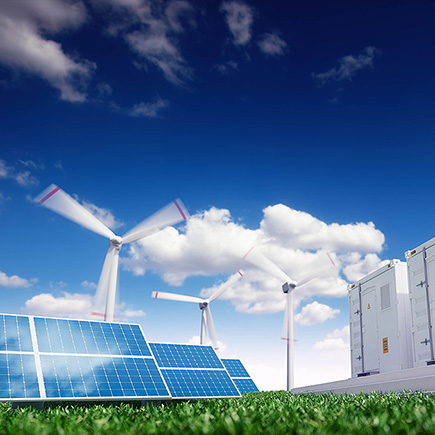Wind power and solar energy are the most widely used renewable energy sources, but while these sources of power are clean and renewable, they have one main disadvantage — they are not available 100% of the time.
Solar power is only available during the day, while wind does not blow continuously. Solar power is, therefore, mostly available when there is less of a need for lighting homes for example. Wind power is a variable resource, and the amount of electricity produced at any given point in time by a given plant will depend on wind speeds, air density, and turbine characteristics (amongst many other factors). If wind speed is too low then the wind turbines will not be able to make electricity, and if it is too high, the turbines will have to be shut down to avoid damage.
So, it’s vital to store the power so that it can be used when it’s required — and that’s where battery energy storage systems (BESS) come into play.
As we know, wind is exceptionally intermittent and unpredictable, hence huge volatility in prices and the normal voltage mismatch problems, leading to an immediate and urgent requirement for BESS.
According to the research firm Rystad Energy, annual battery energy storage system (BESS) installations will grow tenfold between 2022 and 2030.
Improving the interconnection between different variable sources to smooth out supply so sufficient energy is produced even when weather is less favourable, is becoming absolutely critical. The use of batteries to store this power is a necessity to ensure the power can be used whenever you need it.
With batteries, excess power is stored in the battery system, so on those overcast days when your wind or solar system doesn’t produce as much power as you need, you can pull from the batteries, instead of the grid.
Broadly speaking, BESS can provide electricity in response to changes or drops in electricity, provide electricity frequency and voltage regulation, and defer or avoid the need for costly investments in transmission and distribution to reduce congestion. These systems allow us to overcome obstacles caused by the intermittent production of this energy, which is a problem that can never be denied.
Battery storage technologies are essential to speeding up the replacement of fossil fuels with renewable energy.
According to McKinsey, more than $5 billion was invested in BESS during 2022- almost a threefold increase from the previous year. It is expected that the global BESS market will reach between $120 billion and $150 billion by 2030, more than double its size today.
Megawatt Mosaic and our partners have analysed 744 Italian substations. As of 1 April 2023, we have 1.37GWn in grid capacity request, of which 882MWn is grid authorised. We plan to develop the best sites, sell these on at ready-to-build stage and expand into other European locations.
As of September 2023:
- Our investment in a first wave of projects (five projects totalling 430MWn in Italy) is being divested – this will generate 2.5 times the initial capital investment by December 2023.
- Our investment in a second wave of projects (five projects totalling 400MWn in Greece) is progressing in its greenfield phase. We expect to exit the greenfield phase during Q1 2024, with a similar multiple of 2.5 times on invested capital.
- Looking ahead, we are working on identifying a third wave portfolio that could be held to maturity so we can develop the site, complete construction and commence operations.
To find out more, and if you are interested in investing in Megawatt Mosaic, please contact helenp@ megawattmosaic.com
